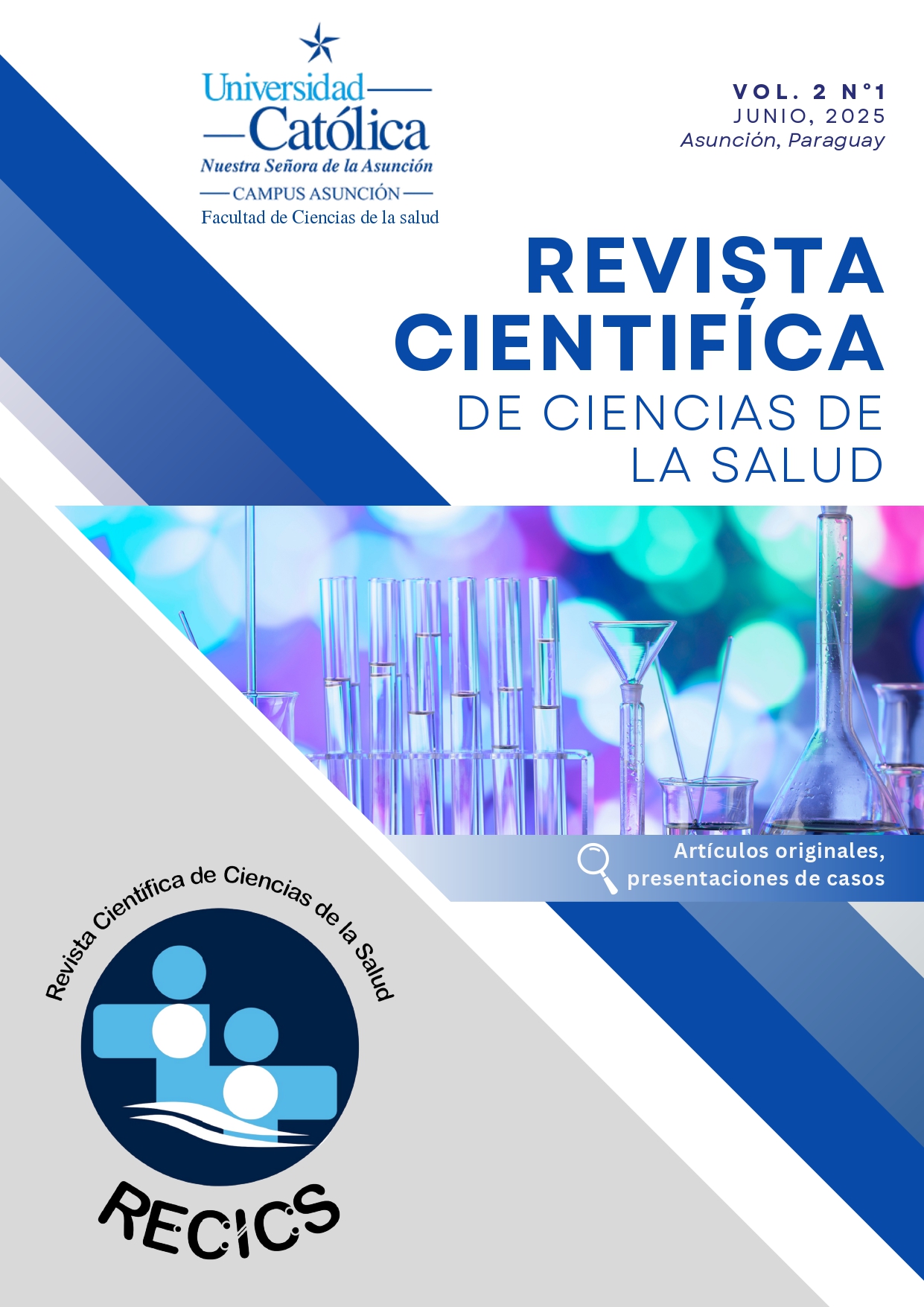Características microbiológicas y resistencia antimicrobiana de gérmenes aislados en urocultivos de pacientes internados en un servicio de pediatría
Palabras clave:
farmacorresistencia, pediatría, agente etiológico, hospitales pediátricosResumen
Introducción: La resistencia antimicrobiana en infecciones pediátricas representa un desafío creciente para la salud pública. En Paraguay, existe información limitada sobre los patrones de resistencia en la población pediátrica, especialmente en centros hospitalarios fuera de la capital. Objetivo: Determinar la frecuencia de resistencia antimicrobiana de los gérmenes aislados en los urocultivos de pacientes internados en el servicio de pediatría del Hospital General de Luque, durante el periodo de octubre del año 2023 a octubre del año 2024. Metodología: Estudio observacional, descriptivo y retrospectivo. Se analizaron los registros médicos y resultados de laboratorio de 121 pacientes pediátricos hospitalizados a quienes se les realizó urocultivo. Se evaluaron características demográficas, resultados microbiológicos, patrones de resistencia y sensibilidad antimicrobiana, y tratamientos utilizados. Resultados: Durante el periodo de estudio se hospitalizaron 121 pacientes con diagnóstico de infección urinaria, de las cuales el 67,77% fueron del sexo pacientes femenino, con predominio de <1 año (38,02%). Del total de urocultivos, el 32,81% resultaron positivos, con predominio de cultivos monomicrobianos (85,71%). Escherichia coli fue el patógeno más frecuente (69,23%), seguido por Klebsiella pneumoniae (7,69%). Se identifican cepas BLEE en 7.69% de los casos. La mayor resistencia se observó frente a Ampicilina/Sulbactam (35,71%) y Cotrimoxazol (23,81%), en tanto que la mayor sensibilidad fue a Gentamicina (69,05%) y Cefazolina (57,14%). El tratamiento más utilizado fue cefotaxima (58,67%), con una duración predominante de 4-7 días (70,25% de los casos). Conclusión: Los hallazgos demuestran una frecuencia considerable de resistencia antimicrobiana, con patrones específicos que deben considerarse en la elección del tratamiento empírico inicial. La alta prevalencia de E. coli y la emergencia de cepas BLEE subrayan la relevancia de la supervisión constante y la exigencia de establecer estrategias para el uso racional de antibióticos en la población pediátrica.
Descargas
Citas
1. Organización Mundial de la Salud, Organización de las Naciones Unidas para la Educación, la Ciencia y la Cultura. Hacer que todas las escuelas sean promotoras de la salud: Pautas e indicadores mundiales. Ginebra: Organización Mundial de la Salud (OMS); 2021.
https://iris.paho.org/bitstream/handle/10665.2/55711/9789275325124_spa.pdf.
2. Organización Mundial de la Salud. 70ª Asamblea Mundial De La Salud: Punto 12.2 del orden del día provisional, 10 de abril de 2017. 2017. http://apps.who.int/gb/ebwha/pdf_files/WHA70/A70_12-sp.pdf.
3. Shkalim Zemer V, Ashkenazi S, Levinsky Y, Richenberg Y, Jacobson E, Nathanson S, Shochat T, Kushnir S, Cohen M, Cohen AH. Pathogens Causing Pediatric Community Acquired Urinary Tract Infections and Their Increasing Antimicrobial Resistance: A Nationwide Study. Pathogens. 2024 Feb 24; 13(3): 201. doi: 10.3390/pathogens13030201. Erratum in: Pathogens. 2025 Feb 05; 14 (2): 150. doi:
10.3390/pathogens14020150. PMID: 38535544; PMCID: PMC10974911.
4. Paredes PL, Celis G, Toapanta IG, Bravo LA. Epidemiología de la infección del tracto urinario en niños, Hospital General de Ambato, Ecuador. INSPILIP. 2017;1(2):1-17. DOI: 10.31790/inspilip.v1i2.29.g34
5. Eremenko R, Barmatz S, Lumelsky N, Colodner R, Strauss M, Alkan Y. Urinary Tract Infection in Outpatient Children and Adolescents: Risk Analysis of Antimicrobial Resistance. Isr Med Assoc J. 2020 [acceso 26/07/2021]; 22(4): 236-40. https://www.ima.org.il/FilesUploadPublic/IMAJ/0/423/211584.pdf.
6. Falup O, Leibovitz E, Vorovenci C, Lixandru R, Rochman F, Monescu V, et al 8. First UTI episode in life in infants <1 year of age: Epidemiologic, clinical, microbiologic and disease recurrence characteristics. Pediatr Neonatol. 2020; 61(6): 613-19. DOI: 10.1016/j.pedneo.2020.07.008.
7. Shaki D, Hodik G, Elamour S, Nassar R, Kristal E, Leibovitz R, et al 9. Urinary tract infections in children < 2 years of age hospitalized in a tertiary medical center in Southern Israel: epidemiologic, imaging, and microbiologic characteristics of first episode in life. Eur J Clin Microbiol Infect Dis. 2020;39(5):955-63. DOI: 10.1007/s10096-019-03810-w.
8. Pérez K, González Y, Pupo A, Santana J, Guilarte C, Vázquez G. Caracterización clínico-humoral de pacientes pediátricos con infección del tracto urinario. Rev 16 de abril. 2020 [acceso 23/02/2022]; 59 (278): 1-4. http://www.rev16deabril.sld.cu/index.php/16_04/article/view/1023.
9. Milá M, Aties L, Torres I. Urocultivo y parcial de orina en el diagnóstico de las infecciones del tracto urinario. Rev Elec Dr. Zoilo E. Marinello Vidaurreta. 2020 [acceso 21/02/2022]; 45 (1): 1-5. http://revzoilomarinello.sld.cu/index.php/zmv/article/view/2038
10. Bello ZL, Cozme Y, Morales I, Pacheco Y, Rua M. Resistencia antimicrobiana en pacientes de edad pediátrica con infección del tracto urinario. Rev Elec Dr.Zoilo E. Marinello Vidaurreta. 2018 [acceso 20/02/2023]; 43 (2): 1-6. https://revzoilomarinello.sld.cu/index.php/zmv/article/view/1271
11. Carriel MG, Ortiz JG. Prevalencia de infección del tracto urinario y perfil de susceptibilidad antimicrobiana en Enterobacterias. Rev vive. 2021 [acceso 20/01/2023]; 4(11): 217-28. https://revistavive.org/index.php/revistavive/article/view/103 18.
12. Molin C, Del Valle E, González L, Figueredo L. Infecciones urinarias en niños con vejiga neurogénica y los patrones de resistencia a los uropatógenos más frecuentes. Mem. Inst. Investig. Cienc. Salud. 2018; 16 (3): 44-50. DOI:
10.18004/Mem.iics/1812-9528/2018.016(03)44-050






